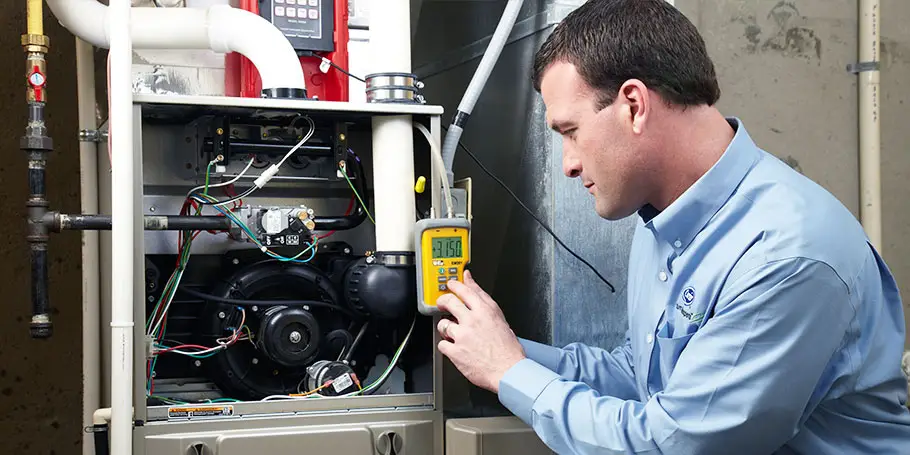A furnace not blowing hot air can make the cold months unbearable. Understanding the common reasons behind this issue and how to troubleshoot them is essential for maintaining comfort in your home. Below, we delve into the reasons your furnace is not heating and provide a comprehensive furnace troubleshooting guide to help you address these problems.

10 Common Furnace Problems
1. Thermostat Issues
Problem: The thermostat controls the furnace’s operation. If it’s not set correctly or is malfunctioning, the furnace won’t heat.
Solution:
- Check the thermostat settings and ensure it is set to “heat.”
- Replace the thermostat batteries if needed.
- If the thermostat is faulty, consider replacing it.
2. Power Supply Problems
Problem: A lack of power can prevent the furnace from functioning. This could be due to a tripped circuit breaker or loose electrical connections.
Solution:
- Check the circuit breaker and reset it if necessary.
- Inspect electrical connections for loose or damaged wires.
3. Pilot Light or Ignition Problems
Problem: In gas furnaces, a faulty pilot light or ignition system can prevent the burners from igniting.
Solution:
- For pilot lights, ensure they are lit and relight if necessary.
- For electronic ignition systems, check for malfunctions and consult a professional if repairs are needed.
4. Gas Supply Issues
Problem: A disrupted gas supply can stop a furnace from heating.
Solution:
- Verify that the gas valve is open.
- Check for gas supply interruptions and contact your gas provider if needed.
5. Clogged Air Filter
Problem: Dirty air filters restrict airflow, causing the furnace to overheat and shut down.
Solution:
- Replace air filters every 1–3 months.
- Use filters recommended by your furnace manufacturer for optimal performance.
6. Blocked Vents or Ducts
Problem: Obstructed vents and ducts disrupt airflow and reduce heating efficiency.
Solution:
- Ensure that all vents are open and clear of furniture or debris.
- Inspect ducts for blockages or damage and clean them as necessary.
7. Faulty Blower Motor
Problem: The blower motor distributes heated air throughout your home. If it’s not working, no heat will reach your living spaces.
Solution:
- Listen for unusual noises that might indicate a faulty blower motor.
- Contact a professional to inspect and repair or replace the motor.
8. Faulty Thermostat Sensor
Problem: A malfunctioning thermostat sensor may not properly signal the furnace to turn on.
Solution:
- Inspect the sensor for damage or incorrect placement.
- Replace the sensor if it’s defective.
9. Dirty or Faulty Flame Sensor
Problem: A dirty flame sensor in gas furnaces can prevent the burners from staying lit.
Solution:
- Turn off the power to the furnace.
- Remove and gently clean the flame sensor with an emery cloth.
- If the sensor is damaged, replace it with a new one.
10. Control Board Issues
Problem: The control board regulates the furnace’s functions. Malfunctions can prevent it from operating properly.
Solution:
- Inspect the control board for loose connections or burn marks.
- Replace faulty components or consult a professional furnace repairman for assistance.
How to Fix a Furnace Not Heating
Step 1: Identify the Problem
Use the above list to pinpoint potential issues with your furnace.
Step 2: Perform Basic Troubleshooting
- Check thermostat settings and power connections.
- Replace dirty air filters.
- Ensure vents and ducts are unobstructed.
Step 3: Clean a Furnace Flame Sensor
If your furnace is not igniting:
- Turn off the power.
- Remove and clean the flame sensor using a fine abrasive pad.
- Reinstall the sensor and test the furnace.
Read the full guide on How to Clean a Furnace Flame Sensor
Step 4: Consult a Professional
For complex issues like blower motor failure or control board malfunctions, contact a licensed HVAC technician for repairs.
Furnace Maintenance Checklist
Regular maintenance can prevent many common furnace problems. Here’s a furnace maintenance checklist to keep your system running efficiently:
- Replace air filters regularly.
- Inspect and clean the flame sensor.
- Check thermostat settings and functionality.
- Clean vents and ducts to ensure proper airflow.
- Test the pilot light or ignition system.
- Inspect the blower motor for wear and tear.
- Ensure electrical connections are secure.
- Schedule annual maintenance services with a professional.
Why Is Furnace Maintenance Important?
- Prevents Breakdowns: Regular care reduces the risk of unexpected failures.
- Improves Efficiency: A well-maintained furnace uses less energy, lowering utility bills.
- Extends Lifespan: Routine servicing prolongs the life of your furnace.
- Enhances Safety: Maintenance reduces the risk of gas leaks or electrical hazards.
When to Call a Furnace Repairman
While some furnace issues can be resolved with DIY troubleshooting, others require professional expertise. Contact a furnace repairman if:
- The furnace doesn’t ignite after cleaning the flame sensor.
- You hear unusual noises from the blower motor.
- There are electrical issues or control board malfunctions.
- The problem persists despite basic troubleshooting efforts.
Conclusion:
A furnace not blowing hot air can stem from a variety of causes, from simple thermostat issues to complex control board malfunctions. By understanding these common furnace problems and following a regular furnace maintenance checklist, you can prevent breakdowns and ensure reliable heating throughout the winter.
For persistent issues or professional care, schedule a service with an experienced HVAC technician. Regular furnace maintenance services are the key to a warm and worry-free home.



